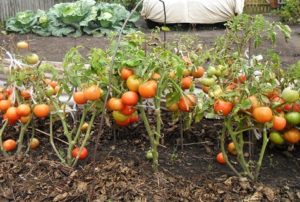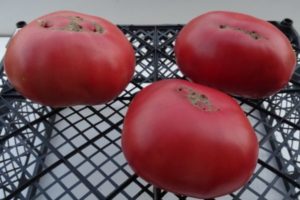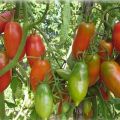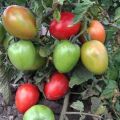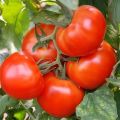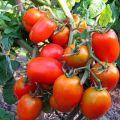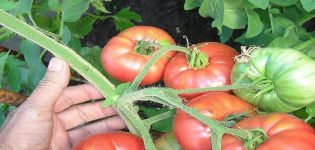Characteristics and description of the tomato variety Volgogradsky early ripening 323, its yield
The Volgograd early ripening tomato was bred for a long time, but it is still popular. A large number of fruits ripen early.
Basic information about the variety
Description of the variety and its appearance:
- belongs to the determinant group and does not require removal of the apex to stop growth;
- the stem is strong, thick in height, stretches up to a maximum of 45 cm, so there is no need to waste time installing a support for the garter;
- many side branches with a lot of foliage;
- the root system does not go deep, but branches out to the sides;
- leaves of a light green color, smooth to the touch;
- the plant belongs to early varieties, the formation and ripening of fruits occurs after 105 days.
Tomato Volgogradsky 323 is suitable for growing in greenhouse conditions or in open beds.
Characteristics of the appearance and taste of tomato fruits:
- the shape of the fruit is round, slightly flattened near the stalk and at the opposite base;
- as they ripen, the color changes from green to yellow, ripe tomatoes are pink-scarlet with an orange tint;
- the weight of one fruit can reach 80 g;
- the skin is thin, but dense and able to protect against cracking;
- the insides are fleshy, juicy;
- withstand transportation, store well and for a long time.
The tomatoes taste sweet with a slight pleasant sourness, with a high content of vitamins. They can be used to make juices, sauces, preparations for the winter, add to salads.
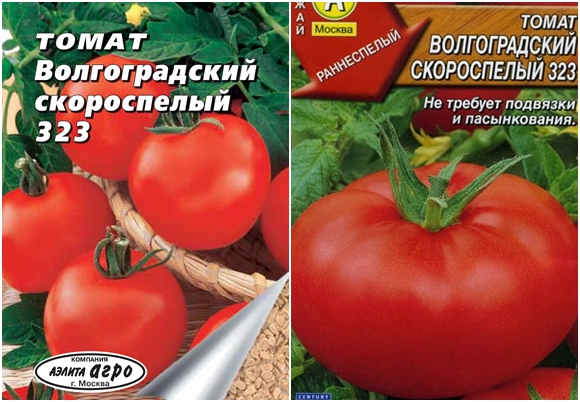
A variety was bred in the Volgograd region by crossing two varieties: Local and Bush Bifstek. Cultivation is possible in all territories of Russia; the climate of the Central, Volgograd, Nizhnevolzhsky districts is best suited.
Positive sides
Volgograd tomatoes are distinguished by high productivity. Up to 6 kg of tomatoes can be harvested from the bushes, which begin to ripen at the same time. But the list of advantages of the species can be continued:
- an early ripe variety will allow you to harvest within three months after planting the seeds;
- the size of the fruits is the same and ripens almost simultaneously, which affects the presentation;
- the berries taste sweet with a pleasant aroma;
- the variety is unpretentious to the composition of the soil;
- does not give in to rotting;
- has a high resistance to disease.
The only drawback of tomatoes, which has been noted in numerous reviews, is poor heat tolerance. The number of ovaries decreases, and isolated cases of the disease are noted.
Since the plant is early ripening, the fruits have time to ripen before the mass spread of diseases. If, nevertheless, the prerequisites for diseases have arisen, it is necessary to spray with preparations or formulations from natural ingredients. Wood ash and herbal infusions are popular.
Conditions for development
Growing begins with the correct selection of seeds. For sowing, you only need to choose large and dense grains. After selection, they need to be held for about two hours in a weak solution of potassium permanganate. Many seasoned vegetable growers soak and germinate seeds. Growth stimulants can be used as impregnation.
The soil should be fertile, with low acidity. Planting grains is best in mid-March. In a container with soil, furrows are made at a distance of 2 cm. Then, in each furrow, holes are made about 1.5 cm deep, into which seeds are planted. After that, you need to water and cover with foil.
As soon as all the sprouts appear, the film is removed and transferred to a well-lit place. After unfolding two leaves, a picking procedure is carried out and transplanted into separate cups.

It is not necessary to allow the appearance of a dry crust; therefore, you need to water the ground regularly. When watering, avoid getting water on the leaves. Do not forget about fertilizing.
Growing seedlings can continue in a greenhouse or in open beds. The place where cabbage or onions used to grow is best. The land is dug up since autumn and fertilizers are applied.
In the spring, grooves are made on the beds at a distance of 40 cm, which will be equal to the size of the root system with an earthen lump. It is recommended to add phosphorus and nitrogen fertilizers to the pits before planting, which the Volgogradets tomato loves so much. To prevent decay, you can add wood ash to the holes.
Further cultivation does not require much time and cost. Rarely enough, but water abundantly, loosen the aisles and weed from weeds. Since the variety is early, during the entire growing season, it has enough nutrients that were introduced before planting. Top dressing is needed only if the summer is cold or the appearance of the plants has changed.
It is useful to mulch the soil where tomatoes grow. As mulch, hay, sawdust, chopped grass are suitable. An additional layer will not allow moisture to evaporate quickly, retain heat, get rid of weeds and reduce the likelihood of disease.
Variety of varieties
Relatively recently, Volgograd pink tomatoes appeared in the Volgograd family. They are the earliest representatives of this group of tomatoes. The first harvest ripens after 85-90 days.
The description of the plant includes the following characteristics:
- strong, stable stem reaches 60 cm in height;
- leaves with a smooth surface are dark green in color;
- fruit weight can reach 120 g;
- round-smooth shape with ribbing near the stalk;
- pulp is fleshy, dense;
- the skin is thin, but able to prevent cracking.

The tomato variety has a high yield and is resistant to major common diseases. The fruits ripen quickly and at the same time, they are stored for a long time.
Seeds for seedlings are sown at the end of March. Seeds are recommended to be treated with disinfectant solutions and growth stimulants. It is recommended to fertilize the soil for seedlings with superphosphate and wood ash.
Planting of grown seedlings is carried out in late May, early June. Furrows are made on the prepared soil, the distance between which is 60 cm. In each furrow, grooves are made at a distance of 25 cm.
Care involves timely watering, loosening, weeding and fertilization.

The emergence of difficulties
Growing tomatoes is easy. But sometimes the Volgograd variety can bring some trouble.
- Do not overdo it with watering. Moistening the soil daily can lead to the development of a fungal disease.A common disease among tomatoes, black leg can destroy the entire crop, therefore, you need to spray the plants with fungicides in time.
- Sowing seeds too early can cause the seedlings to pull out. The problem is caused by the tight capacity and lack of light. Landing in a permanent place can save the day.
- It happens that the seedling breaks. Do not throw it away immediately. It is worth separating the bad roots and planting the plant in a glass of water for several days. The field of this sprout can be returned to the ground.
- At hot air temperatures or during prolonged rainy days, the plant stops developing and becomes susceptible to disease.
Volgograd tomato pleases with a high yield. If you familiarize yourself with all the features of growing and caring for a plant, then you can avoid mistakes and invest a minimum of effort.
